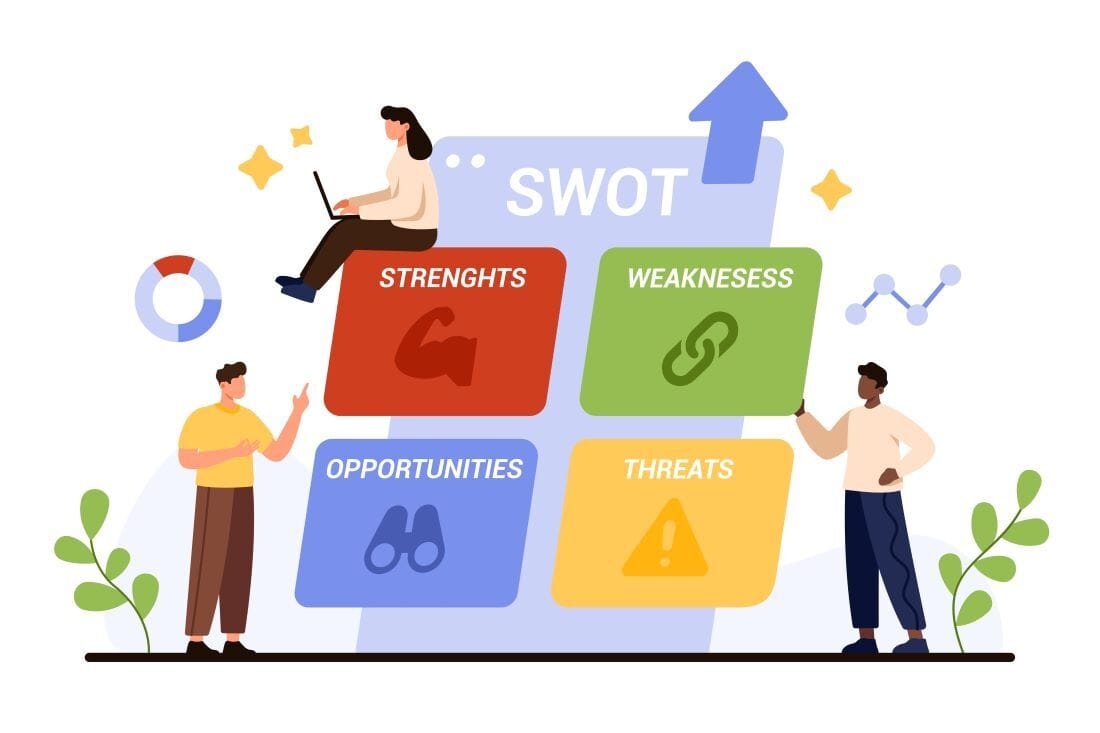- Raising InvestorIQ Newsletter
- Posts
- SWOT Analysis
SWOT Analysis
A Key Tool for Strategic Investment Analysis

DISCLOSURE: THIS POST MAY CONTAIN AFFILIATE LINKS, MEANING I GET A COMMISSION IF YOU DECIDE TO MAKE A PURCHASE THROUGH MY LINKS, AT NO COST TO YOU. PLEASE READ MY DISCLOSURE FOR MORE INFO.


Good morning investors!
If this is your first time reading, welcome to Raising InvestorIQ!
Every Sunday morning, we publish a free write-up within our RIIQ Newsletter with leading insight and analysis — the aim is to help investors of all skill levels focus on key fundamentals, gain confidence in developing an investment strategy, and gain an edge in the push to generate true wealth.
Grab your coffee and let’s dive in!
Deep-Dive
Intro
If you're diving into the world of investment analysis, a solid tool to familiarize yourself with is SWOT Analysis.
Typically associated with strategic business management, this simple tool is just as effective for investors looking to assess a company’s strengths, weaknesses, opportunities, and threats (SWOT).
In this guide, we’ll break down how you, as an investor, can use SWOT to evaluate potential investments and make smarter, more informed decisions.
Why SWOT Matters
Let’s start with the basics: SWOT stands for Strengths, Weaknesses, Opportunities, and Threats.
Its framework businesses use to evaluate their internal and external environments. For investors, SWOT is like a compass that helps you figure out if a company is set for long-term success or if it’s facing some serious hurdles.
Think of it as a health check for a potential investment: it gives you a clear picture of in which the company excels, in which it’s struggling, which opportunities it might grab for advancement, and which risks it could run into.
Since the 1960s, SWOT Analysis has evolved from a simple business tool into a comprehensive framework that offers a 360-degree view of a company’s market position.
For investors, this evolution makes SWOT a must-have. It helps you see if a company’s strategy aligns with market realities and whether it’s likely to grow and succeed.
By examining a company’s strengths, you can spot its competitive advantages (if any); analyzing its weaknesses helps you identify potential roadblocks; and evaluating opportunities and threats gives you insight into external factors that could impact its performance.
Without a well-structured tool like SWOT, picking the right investments can feel like a shot in the dark. It brings clarity and focus, helping you zero in on promising opportunities while steering clear of risky ventures.
Uncovering Strengths and Weaknesses

When you start digging into a company as a potential investment, the first thing you’ll want to check out is its strengths. These are the internal factors that make it stand out—things like an industry-leading product, a strong brand, or crazy loyal customers.
These are the kind of traits that give a company a real edge and help it succeed long-term. For example, if a company nails customer service, it might have higher retention rates, meaning more stable and predictable revenue, so basically a good starting point!
But it’s not all sunshine and rainbows. You’ve got to look at the weaknesses too. These are the internal hiccups that could hold the company back—outdated tech, clunky operations, or maybe they’re betting too much on one product.
These weaknesses can stop a company from growing or responding to market changes. For instance, if a company’s marketing is falling flat compared to its competitors, that’s a red flag.
Struggling to attract new customers? Not a great look for profitability.
Receive Honest News Today
Join over 4 million Americans who start their day with 1440 – your daily digest for unbiased, fact-centric news. From politics to sports, we cover it all by analyzing over 100 sources. Our concise, 5-minute read lands in your inbox each morning at no cost. Experience news without the noise; let 1440 help you make up your own mind. Sign up now and invite your friends and family to be part of the informed.
Spotting Opportunities and Threats
SWOT also helps you zoom out and see the bigger picture by highlighting a company’s external opportunities and threats.
Opportunities are those outside factors that could give the company a boost and unlock some serious growth. For investors, this could mean things like breaking into new markets, riding the wave of tech advancements, or taking advantage of industry trends.
If a company is in a prime spot to grab these opportunities, it could be looking at some major growth potential—which is exactly what you want to see when considering an investment!
Now, let’s not forget about the threats. These are the external risks that could throw a wrench in the company’s game plan. We’re talking increased competition, new regulations, economic downturns, or even changing consumer tastes.
For example, if a company suddenly faces a competitor with better products or lower prices, it could start losing market share fast. And that’s definitely something you’d want to think twice about before jumping in.
Real-life Example With MICROSOFT
Let’s get concrete. To see how SWOT can help you as an investor, let’s take a look at Microsoft.
As one of the largest and most valuable companies in the world, Microsoft provides an interesting example of how SWOT Analysis can break down its position in the market.
Strengths
Dominant market share in operating systems and productivity software
Strong brand loyalty and a broad product portfolio
Leadership in cloud computing through Azure
Exceptional financial health, with consistent revenue growth and high profitability
Weaknesses
Heavy reliance on its Windows and Office products, making it vulnerable to shifts in these markets
Vulnerabilities to cybersecurity threats, which remain a significant concern for tech companies
Struggles in the smartphone and internet browser markets
Opportunities
Significant growth potential in cloud computing, with Azure capturing more market share
Advancements in artificial intelligence and strategic acquisitions that could fuel future innovation
Expanding influence in gaming with Xbox and virtual reality technologies
Threats
Intense competition from other tech giants like Google and Apple
Changing consumer needs, particularly as PC sales decline
Legal challenges and reputational risks from accusations of anti-competitive practices
As an investor, Microsoft’s strengths, such as its leadership in cloud computing and its broad product portfolio, are encouraging signs. However, its weaknesses—like over-reliance on key products—combined with threats from intense competition and regulatory issues, mean there are some risks to consider as well.

A Valuable Tool
Using SWOT in your investment analysis is like having a trusty roadmap—it gives you a clear, structured way to really dig into potential investments. It’s not just about scratching the surface.
SWOT helps you go deeper, giving you a solid, data-driven picture of where a company stands now and where it could go in the future. So, instead of making decisions based on gut feelings, you’re backed by a smart and precise breakdown of the company.
It also makes planning ahead a whole lot easier. As an investor, it helps you spot potential bumps in the road and see if the companies you’re betting on can handle them.
For instance, if a startup has killer tech (strength) but is up against stiff competition (threat), you’ll know what hurdles might need clearing for your investment to pay off. With that kind of insight, you can move forward with more confidence and a clearer game plan.
Common Pitfalls and How to Avoid Them
To really make the most of SWOT, it’s key to keep your biases in check. It’s way too easy to let personal preferences or gut feelings sneak in and cloud your judgment, which can lead to some not-so-great investment moves. Instead, keep things grounded in the hard facts—dive into financial reports, look at market trends, and dig through industry insights.
It’s also smart to get a few different perspectives involved. The more viewpoints you bring in, the more balanced and well-rounded your analysis will be. And don’t forget, SWOT isn’t a one-and-done thing.
The market is constantly shifting, so updating your analysis on a regular basis will keep everything fresh and relevant. It’s like giving your investment approach a quick refresh every now and then, ensuring you stay ahead of the game with sharper, up-to-date insights.
Keeping things dynamic means, you’ll always have your finger on the pulse.
Future Trends
Technology is giving SWOT a serious upgrade, especially with the rise of artificial intelligence (AI).
AI tools can sift through mountains of data faster and more accurately than ever, making it easier for you to spot trends and potential risks. It’s like having a supercharged assistant that helps you make smarter, quicker decisions, keeping you one step ahead of the competition.
But it’s not just about AI. Globalization and sustainability are also becoming big players in investment analysis. Companies that can keep up with global trends and focus on eco-friendly solutions are set to thrive in the future.
For investors, this means paying close attention to a company’s sustainability efforts and how it navigates the global market could be the secret to picking long-term winners. With these trends shaping the future, having a keen eye on these factors could give your investment strategy the edge it needs!
Conclusion
For investors, SWOT is like the Swiss Army knife of analysis—simple but seriously effective for getting a clear snapshot of a company. Use it regularly, and you’ll be making sharper, more informed investment moves that line up with what’s happening both inside the company and out in the market.
Plus, with cool tech like AI giving SWOT an upgrade, it’s only getting better at helping you spot golden opportunities and dodge potential risks.
So go ahead, make SWOT your new investment best friend - it could be your secret weapon for unlocking long-term growth and riding the waves of an ever-changing market; but don't forget that an investment analysis should never be carried out with just one tool!
Stay tuned for more tools!
Key Insight
SWOT helps you go deeper, giving you a solid, data-driven picture of where a company stands now and where it could go in the future.
So, instead of making decisions based on gut feelings, you’re backed by a smart and precise breakdown of the company.
Visit and subscribe for FREE to the Raising InvestorIQ YouTube Channel for more leading Investing info, insight, and analysis.
Disclosure/Disclaimer
As a Tykr affiliate, Raising InvestorIQ earns from qualifying purchases. As a Seeking Alpha affiliate, Raising InvestorIQ earns from qualifying purchases.
Information provided on this site is based on my own personal experience, research, and analysis, and it is not to be construed as professional advice. Please conduct your own research before making any investment decisions. I am not a professional financial advisor, stockbroker, or planner, nor am I a CPA or a CFP.
The contents of this site and the resources provided are for informational and entertainment purposes only and do not constitute financial, accounting, or legal advice. The author is not liable for any losses or damages related to actions or failure to act related to the content on this website.




